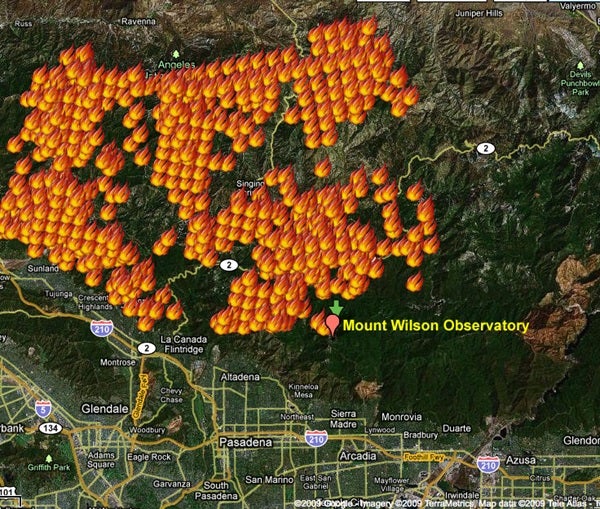4:35 p.m. Central
Despite smoke perilously close to the observatory buildings and the failure of the UCLA Towercam, MWO director Harold McAlister reported Wednesday, “The situation on the mountain remains stable with very good prospects.”
The Towercam, which for much of the fire functioned as the only way to see the fire in the Mount Wilson vicinity, went down Tuesday night along with the rest of the observatory’s Internet connections. McAlister wrote in a recent update the outage was due to the melting of some fiberglass panels covering the communications lines.
And the scary nearby fires turn out to have been backfires deliberately set to burn the inflammable brush and debris in a controlled way, keeping the trees from going up in flames. In addition, 7,500 gallons of retardant gel dropped from planes and the 750,000 gallons of water in the observatory’s potable tanks have both slowed the spreading of Station Fire.
While the risk is not completely gone, the worst now seems over. Firefighters will remain on Mount Wilson until it’s deemed safe.
McAlister wrote that LA County Deputy Fire Chief Jim Powers was “absolutely confident” the observatory would survive.
3:07 p.m. Central
MWO director Harold McAlister reports, “The situation on the mountain remains stable with very good prospects.”
9:38 a.m. Central Mount Wilson Observatory remains intact. A 747 “Super Scooper” dropped 7,500 gallons of fire retardant gel on the mountain Tuesday night.
We’ve posted a full-length feature article about the history of Mount Wilson Observatory. Read “Mount Wilson Observatory: View from the mountaintop,” by Sallie Baliunas, to learn more about this historic facility.
September 1, 2009
2:49 p.m. Central KTLA live aerial coverage of the fire on Mount Wilson
Editor’s note: Footage subject to change.
2:08 p.m. Central CBS News live video of fire encroaching upon Mount Wilson Observatory
Editor’s note: This footage scans Mount Wilson and the surrounding area. Mount Wilson Observatory is not always the focal point of the video.
August 31, 2009
California’s century-old Mount Wilson Observatory, home to some of the world’s largest telescopes and instrumental in shaping much of current astronomical theory, lies in the midst of Angeles National Forest, where an enormous fire has raged since August 26. Called “Station Fire,” it has forced the evacuation of thousands, destroyed at least 20 homes, and caused the deaths of two firefighters. Only 5 percent of the fire is contained so far.
According to the observatory’s web site, which has been providing status updates, fire crews had to evacuate the Mount Wilson area early Monday morning. Fire activity in the observatory’s vicinity had diminished, observatory Director Harold McAlister wrote, but no firefighters remained on the scene. The observatory’s UCLA Towercam has been providing live photos of the wildfires as they advance through the forest.
The observatory’s fate remains uncertain as the hot, dry weather, predicted to last through Tuesday, keeps Station Fire from dying out. “It’s a flip of the coin,” said Dave Jurasevich, the observatory’s superintendent and along with firefighters one of the last to leave. “The fire’s been capricious, and even the professionals don’t know where it’ll go.” The Los Angeles Times said firefighters and some officials believe it’s just a matter of time before the fire reaches the 5,710-foot peak.
In addition to the observatory building, Mount Wilson also houses dozens of TV, radio, and cell phone communications towers – making it one of the forest’s most watched sites. NASA’s Jet Propulsion Laboratory, located nearby, may also be in danger, but faces no immediate threat.
Mount Wilson Observatory’s 60-inch telescope, the world’s largest exclusively available to the public, and its Hooker 100-inch telescope helped establish the Solar System’s current place in the galaxy. Edwin Hubble used the Hooker telescope to discover that galaxies exist outside of the Milky Way and that most are receding from us, thus implying the Big Bang. It currently houses millions of dollars’ worth of other scientific equipment, as well as an astronomical museum.
Jurasevich said the observatory had up-to-date water systems and had cleared nearby brush, so it is as prepared as possible to weather the fire. But ultimately, he said, it’s out of everyone’s hands, calling the possible loss of the observatory heartbreaking.
“It would be absolutely tragic for science, for astronomy, and really for the nation.”
More coverage of the Station Fire:
- Get updated images from the UCLA Towercam. [Editor’s note: Due to the large amount of traffic to the Towercam site, the page is loading slowly.]
- Follow The Los Angeles Times‘ live Twitter coverage of the fires: @latimesfires.














